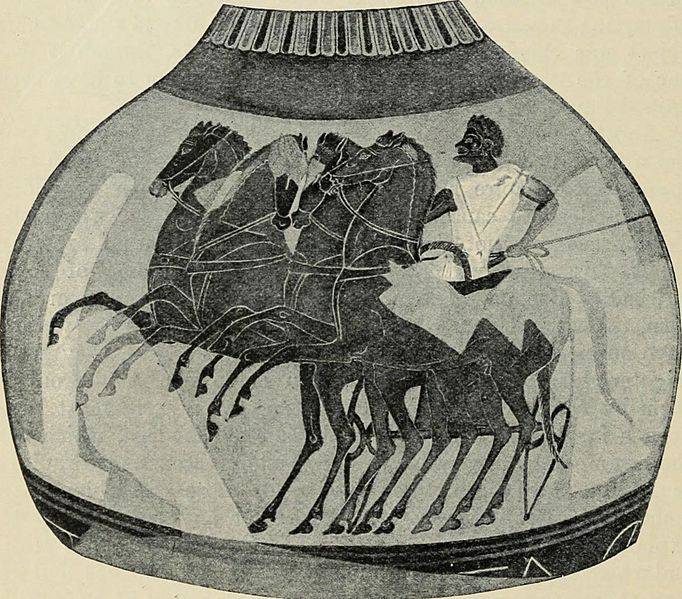Archivo: Greek athletic sports and festivals (1910) (14583876537)

Descripción: Identifier: greekathleticspo00gard (find matches) Title: Greek athletic sports and festivals Year: 1910 (1910s) Authors: Gardiner, E. Norman (Edward Norman), 1864-1930 Subjects: Athletics Sports Olympics Fasts and feasts Publisher: London : Macmillan and Co. Contributing Library: Harold B. Lee Library Digitizing Sponsor: Brigham Young University View Book Page: Book Viewer About This Book: Catalog Entry View All Images: All Images From Book Click here to view book online to see this illustration in context in a browseable online version of this book. Text Appearing Before Image: , while at Nemea the panic ofthe horses was caused by a gleam like fire reflected from a redstone near the turn. But nowhere was there any Taraxippuswhich inspired such terror as the Taraxippus at Olympia ! ^ It can hardly have been as fair ; for the outside chariots had the enormousadvantage of a flying start. I conjecture, however, that the chariots did not reallystart racing till they were all in line, and that the object of the aphesis waspartly to facilitate the getting them into line, no easy matter with a large field. 456 GREEK ATHLETIC SPORTS AND FESTIVALS CHAP. The Olympic aphesis was something exceptional. Usuallyhorses and chariots were started much in the same way asrunners. Lots were drawn for places, and they drew up in line.^It appears that a rope (vcnrXr)^) was stretched in front of thewhole lin^, which was dropped, or removed at the moment ofstarting. How this rope was dropped without risk of entanglingthe horses feet, is a mystery ; there is no record of any accident Text Appearing After Image: Fig. 165.—Panathenaic ami^huiu IulUiu at Sparta. Sixth century. caused at the start. The signal for the start was given by atrumpet. The horse-races, being mostly of the diaulos type,finished at the start. The only place where we hear of straightraces is at Athens. The starting-line, as in the stadium, wasprobably marked by pillars at either end. The pillars re-presented on coins and vases may be either these pillars or thepillars round which the horses turned. On a fine Panathenaicvase (Fig. 165) recently discovered at Sparta there is a spirited 1 Sophocles, M. 709. XXI THE HIPPODROME—PROGRAMME 457 drawing of a four-horse chariot passing a pillar on its right.As the turn always took place to the left, it is clear that unlessthe artist has made a mistake, the pillar represents the finish. We have seen that the fully developed programme comprisedsix events, three for full-grown horses (reAetot), three for colts,for each class a four-horse chariot-race (a/3/xa, rkOpi-Kirov), a horse Note About Images Please note that these images are extracted from scanned page images that may have been digitally enhanced for readability - coloration and appearance of these illustrations may not perfectly resemble the original work.
Título: Greek athletic sports and festivals (1910) (14583876537)
Créditos: https://www.flickr.com/photos/internetarchivebookimages/14583876537/ Source book page: https://archive.org/stream/greekathleticspo00gard/greekathleticspo00gard#page/n484/mode/1up
Autor(a): Internet Archive Book Images
Permiso: At the time of upload, the image license was automatically confirmed using the Flickr API. For more information see Flickr API detail.
Términos de Uso: No known copyright restrictions
Licencia: No restrictions
Enlace de Licencia: https://www.flickr.com/commons/usage/
¿Se exige la atribución?: No
Usos del archivo
La siguiente página enlaza a este archivo:

